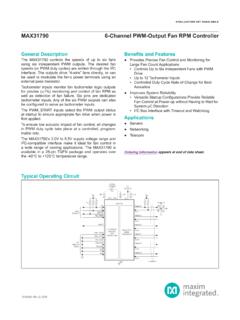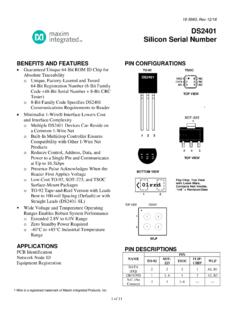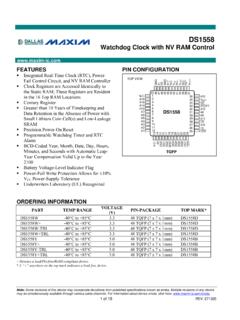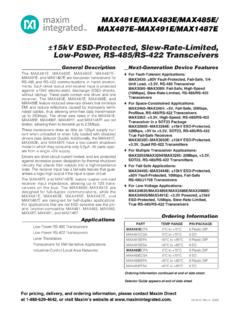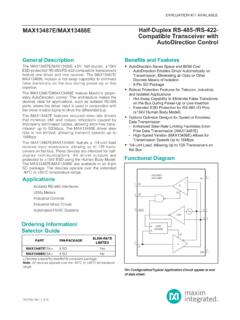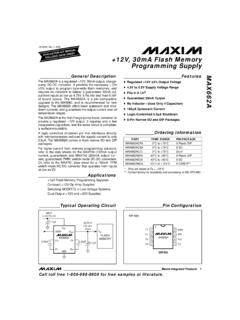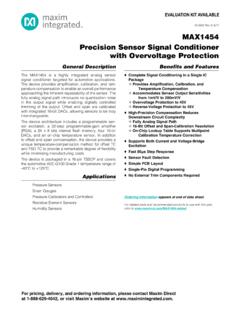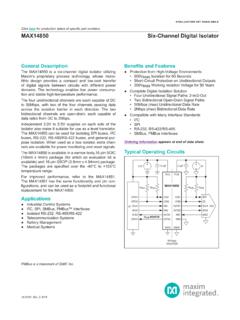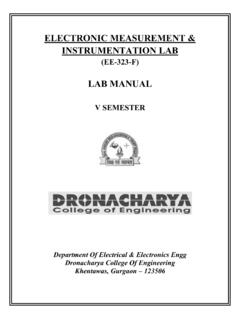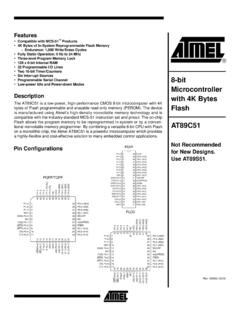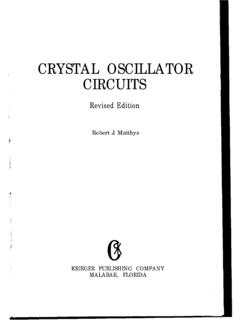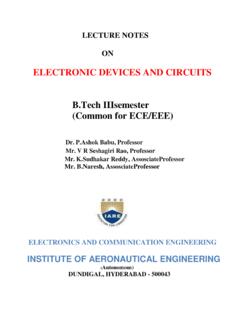Transcription of 64 x 8, Serial, I2C Real-Time Clock - Maxim Integrated
1 DS1307. 2. 64 x 8, Serial, I C Real-Time Clock GENERAL DESCRIPTION BENEFITS AND FEATURES. The DS1307 serial Real-Time Clock (RTC) is a low- Completely Manages All Timekeeping Functions power, full binary-coded decimal (BCD) Clock /calendar o Real-Time Clock Counts Seconds, Minutes, plus 56 bytes of NV SRAM. Address and data are Hours, Date of the Month, Month, Day of the 2. transferred serially through an I C, bidirectional bus. Week, and Year with Leap-Year The Clock /calendar provides seconds, minutes, hours, Compensation Valid Up to 2100. day, date, month, and year information. The end of o 56-Byte, Battery-Backed, General-Purpose the month date is automatically adjusted for months RAM with Unlimited Writes with fewer than 31 days, including corrections for leap o Programmable Square-Wave Output Signal year. The Clock operates in either the 24-hour or 12- Simple Serial Port Interfaces to Most hour format with AM/PM indicator.
2 The DS1307 has a Microcontrollers built-in power-sense circuit that detects power failures 2. o I C Serial Interface and automatically switches to the backup supply. Timekeeping operation continues while the part Low Power Operation Extends Battery Backup operates from the backup supply. Run Time o Consumes Less than 500nA in Battery- TYPICAL OPERATING CIRCUIT Backup Mode with Oscillator Running VCC o Automatic Power-Fail Detect and Switch VCC Circuitry crystal 8-Pin DIP and 8-Pin SO Minimizes Required VCC RPU RPU. Space X1 X2 VCC Optional Industrial Temperature Range: -40 C to SCL SQW/OUT +85 C Supports Operation in a Wide Range of CPU Applications DS1307. Underwriters Laboratories (UL) Recognized SDA VBAT. GND. RPU = tr/Cb PIN CONFIGURATIONS. TOP VLEW. X1 VCC X1 VCC. X2 SQW/OUT X2 SQW/OUT. VBAT SCL VBAT SCL. GND SDA GND SDA. SO (150 mils) PDIP (300 mils).
3 ORDERING INFORMATION. PART TEMP RANGE VOLTAGE (V) PIN-PACKAGE TOP MARK*. DS1307+ 0 C to +70 C 8 PDIP (300 mils) DS1307. DS1307N+ -40 C to +85 C 8 PDIP (300 mils) DS1307N. DS1307Z+ 0 C to +70 C 8 SO (150 mils) DS1307. DS1307ZN+ -40 C to +85 C 8 SO (150 mils) DS1307N. DS1307Z+T&R 0 C to +70 C 8 SO (150 mils) Tape and Reel DS1307. DS1307ZN+T&R -40 C to +85 C 8 SO (150 mils) Tape and Reel DS1307N. +Denotes a lead-free/RoHS-compliant package. *A + anywhere on the top mark indicates a lead-free package. An N anywhere on the top mark indicates an industrial temperature range device. Underwriters Laboratories, Inc. is a registered certification mark of Underwriters Laboratories, Inc. 1 of 14 REV: 3/15. 2. DS1307 64 x 8, Serial, I C Real-Time Clock ABSOLUTE MAXIMUM RATINGS. Voltage Range on Any Pin Relative to Ground .. to + Operating Temperature Range (Noncondensing).
4 Commercial .. 0 C to +70 C. Industrial .. -40 C to +85 C. Storage Temperature Range .. -55 C to +125 C. Soldering Temperature (DIP, leads) .. +260 C for 10 seconds Soldering Temperature (surface mount) ..Refer to the JPC/JEDEC J-STD-020 Specification. Stresses beyond those listed under Absolute Maximum Ratings may cause permanent damage to the device. These are stress ratings only, and functional operation of the device at these or any other conditions beyond those indicated in the operational sections of the specifications is not implied. Exposure to the absolute maximum rating conditions for extended periods may affect device reliability. RECOMMENDED DC OPERATING CONDITIONS. (TA = 0 C to +70 C, TA = -40 C to +85 C.) (Notes 1, 2). PARAMETER SYMBOL CONDITIONS MIN TYP MAX UNITS. Supply Voltage VCC V. Logic 1 Input VIH VCC + V. Logic 0 Input VIL + V.
5 VBAT Battery Voltage VBAT 3 V. DC ELECTRICAL CHARACTERISTICS. (VCC = to ; TA = 0 C to +70 C, TA = -40 C to +85 C.) (Notes 1, 2). PARAMETER SYMBOL CONDITIONS MIN TYP MAX UNITS. Input Leakage (SCL) ILI -1 1 A. I/O Leakage (SDA, SQW/OUT) ILO -1 1 A. Logic 0 Output (IOL = 5mA) VOL V. Active Supply Current ICCA mA. (fSCL = 100kHz). Standby Current ICCS (Note 3) 200 A. VBAT Leakage Current IBATLKG 5 50 nA. x x x Power-Fail Voltage (VBAT = ) VPF V. VBAT VBAT VBAT. DC ELECTRICAL CHARACTERISTICS. (VCC = 0V, VBAT = ; TA = 0 C to +70 C, TA = -40 C to +85 C.) (Notes 1, 2). PARAMETER SYMBOL CONDITIONS MIN TYP MAX UNITS. VBAT Current (OSC ON);. IBAT1 300 500 nA. SQW/OUT OFF. VBAT Current (OSC ON);. IBAT2 480 800 nA. SQW/OUT ON (32kHz). VBAT Data-Retention Current IBATDR 10 100 nA. (Oscillator Off). WARNING: Negative undershoots below while the part is in battery-backed mode may cause loss of data.
6 2 of 14. 2. DS1307 64 x 8, Serial, I C Real-Time Clock AC ELECTRICAL CHARACTERISTICS. (VCC = to ; TA = 0 C to +70 C, TA = -40 C to +85 C.). PARAMETER SYMBOL CONDITIONS MIN TYP MAX UNITS. SCL Clock Frequency fSCL 0 100 kHz Bus Free Time Between a STOP and tBUF s START Condition Hold Time (Repeated) START. tHD:STA (Note 4) s Condition LOW Period of SCL Clock tLOW s HIGH Period of SCL Clock tHIGH s Setup Time for a Repeated START. tSU:STA s Condition Data Hold Time tHD:DAT 0 s Data Setup Time tSU:DAT (Notes 5, 6) 250 ns Rise Time of Both SDA and SCL. tR 1000 ns Signals Fall Time of Both SDA and SCL. tF 300 ns Signals Setup Time for STOP Condition tSU:STO s CAPACITANCE. (TA = +25 C). PARAMETER SYMBOL CONDITIONS MIN TYP MAX UNITS. Pin Capacitance (SDA, SCL) CI/O 10 pF. Capacitance Load for Each Bus CB (Note 7) 400 pF. Line Note 1: All voltages are referenced to ground.
7 Note 2: Limits at -40 C are guaranteed by design and are not production tested. Note 3: ICCS specified with VCC = and SDA, SCL = Note 4: After this period, the first Clock pulse is generated. Note 5: A device must internally provide a hold time of at least 300ns for the SDA signal (referred to the VIH(MIN) of the SCL. signal) to bridge the undefined region of the falling edge of SCL. Note 6: The maximum tHD:DAT only has to be met if the device does not stretch the LOW period (tLOW) of the SCL signal. Note 7: CB total capacitance of one bus line in pF. 3 of 14. 2. DS1307 64 x 8, Serial, I C Real-Time Clock TIMING DIAGRAM. SDA. tBUF. tHD:STA. tLOW. tR tF. SCL. tHD:STA tSU:STA. tHIGH. tSU:STO. STOP START SU:DAT. REPEATED. START. tHD:DAT. Figure 1. Block Diagram 4 of 14. 2. DS1307 64 x 8, Serial, I C Real-Time Clock TYPICAL OPERATING CHARACTERISTICS.
8 (VCC = , TA = +25 C, unless otherwise noted.). ICCS vs. VCC V BAT= IBAT vs. VBAT V CC = 0V. 120 400. SQW=32kHz 110. 100 350. 90. SUPPLY CURRENT (nA. SUPPLY CURRENT (uA. 80 300. 70. 60 250. 50 SQW off 40 200. 30. 20 150. 10. 0 100. VCC (V) VBACKUP (V). IBAT vs. Temperature V CC=0V, V BAT= SQW/OUT vs. Supply Voltage SQW=32kHz SUPPLY CURRENT (nA. FREQUENCY (Hz). 32768. SQW off -40 -20 0 20 40 60 80 Supply (V). TEMPERATURE ( C). 5 of 14. 2. DS1307 64 x 8, Serial, I C Real-Time Clock PIN DESCRIPTION. PIN NAME FUNCTION. Connections for Standard quartz crystal . The internal oscillator circuitry is 1 X1 designed for operation with a crystal having a specified load capacitance (CL) of X1 is the input to the oscillator and can optionally be connected to an external oscillator. The output of the internal oscillator, X2, is floated if an external oscillator is connected to X1.)))
9 2 X2 Note: For more information on crystal selection and crystal layout considerations, refer to Application Note 58: crystal Considerations with Dallas Real-Time Clocks. Backup Supply Input for Any Standard 3V Lithium Cell or Other Energy Source. Battery voltage must be held between the minimum and maximum limits for proper operation. Diodes in series between the battery and the VBAT pin may prevent proper operation. If a backup supply is not required, VBAT must be grounded. The nominal power-fail trip point 3 VBAT (VPF) voltage at which access to the RTC and user RAM is denied is set by the internal circuitry as x VBAT nominal. A lithium battery with 48mAh or greater will back up the DS1307 for more than 10 years in the absence of power at +25 C. UL recognized to ensure against reverse charging current when used with a lithium battery.
10 Go to: 4 GND Ground 2. Serial Data Input/Output. SDA is the data input/output for the I C serial interface. The 5 SDA SDA pin is open drain and requires an external pullup resistor. The pullup voltage can be up to regardless of the voltage on VCC. 2. Serial Clock Input. SCL is the Clock input for the I C interface and is used to synchronize 6 SCL data movement on the serial interface. The pullup voltage can be up to regardless of the voltage on VCC. Square Wave/Output Driver. When enabled, the SQWE bit set to 1, the SQW/OUT pin outputs one of four square-wave frequencies (1Hz, 4kHz, 8kHz, 32kHz). The SQW/OUT. 7 SQW/OUT pin is open drain and requires an external pullup resistor. SQW/OUT operates with either VCC or VBAT applied. The pullup voltage can be up to regardless of the voltage on VCC. If not used, this pin can be left floating.

